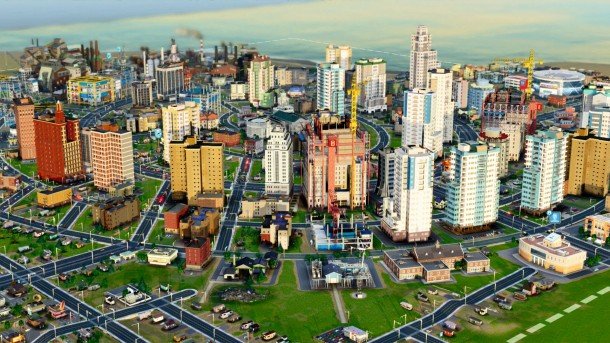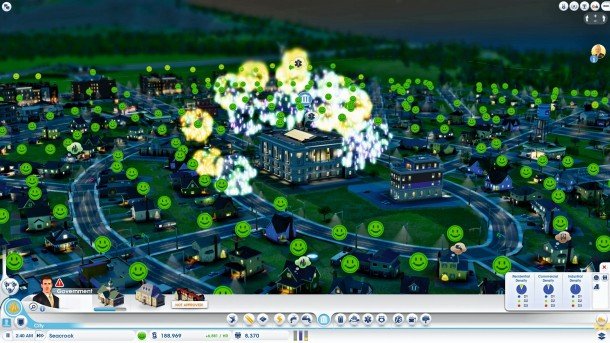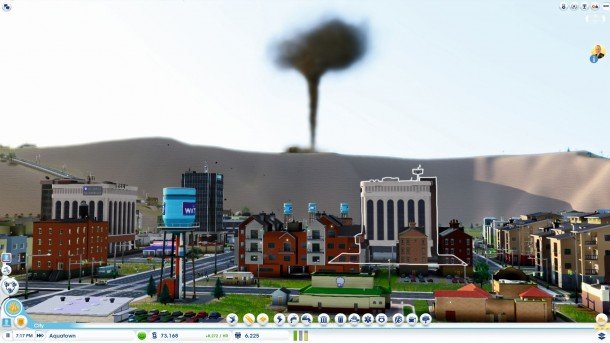SimCity hands-on: "clever, beautiful and terribly, terribly addictive"

Hobo Town is thriving. I've just upgraded City Hall from a modest townhouse to a sandstone palace and the entire city is celebrating. Fireworks burst overhead. Citizens cheer. Green smilies spring from every building in a great concentric shockwave with City Hall at its centre. I've set off a 20-ton payload of pure joy. It feels amazing. I am a brilliant mayor.
"I've set off a 20-ton payload of pure joy. It feels amazing. I am a brilliant mayor."
It's not the sort of hit I expect from a citybuilding sim. The SimCity series has always provided a banquet of slow-burn rewards for the patient, analytical player. The compulsive pleasure of creating well-organised districts with perfectly spaced roads and excellent healthcare. The smugness of seeing your city's coffers swell with tax takings as big industry takes root. With the help of the new Glassbox Engine, this reboot from Maxis adds a sleek layer of polish and a spark of instant gratification.
Hobo Town wasn't always a paradise. Not long ago my people were wading through sewage. My lazy scattering of health clinics were stretched to breaking point as citizens fell sick. The prosperous grid of industrial complexes I had constructed to the north started farting putrid yellow clouds into my high-rise apartment blocks in the city centre, poisoning more people and damaging property values in Hobo Town's most opulent area.

The Glassbox engine lets you examine the damage through a collection of visual overlays. Information contained in tables and popups in previous SimCity games is projected onto your 3D view of the city in real-time. Select the sewage overlay and you'll see waste flowing in dark blobs as if down your city's streets. Blobs that emerge near outflow pipes lurch towards them in waves, like dark blood cells pulsing through asphalt veins. The rest coalesce and come to a stop. If you zoom in you hear disgusted citizens retching.
"Hobo Town's citizens now only existed to support the city's growing germ population."
You can view your city through dozens of info-lenses. The water overlay renders the terrain in shades of blue. Deeper shades indicate superior water tower sites. The land value view draws 3D graph bars on every building in the city. The tallest, greenest stems are on the cusp of upgrading to larger, more productive structures. Public transport coverage is drawn like a heat map on your streets. You can even see which buildings in your city have highest germ population.
It was the final view that told me all I needed to know about Hobo Town's single biggest problem. Every building burned bright red. I realised that Hobo Town's citizens now only existed to support the city's growing germ population. If germs could vote, I'd struggle to think of a reason to keep people around.
Surviving germ-o-geddon proved tricky. Citizens require jobs, good transport, places to shop and parks to have romantic walks in. Running a city means facing down a cacophony of needs, and it's impossible to please everyone. The extra sewage outflow pipes I had to install triggered waves of disgust in local areas. Then a serial killer started a rampage. There are many, many plates to spin.
The biggest gaming news, reviews and hardware deals
Keep up to date with the most important stories and the best deals, as picked by the PC Gamer team.

SimCity's complexity is softened by disarming, vibrant visuals. Every building looks like a pristine miniature. Peg-like citizens garble nonsense to themselves as they walk the streets. With a flick of the mousewheel you can drop from your heavenly perspective and observe their daily routines. Click and you'll find that every citizen has a name, concerns, a home and a job. If they're unemployed and unhappy they can turn to crime and police officers with tiny guns will arrest them in the street.
"Sims' movements directly affect the running of your city."
This isn't just visual fluff. Your sims' movements directly affect the running of your city. A shop won't open for the day until the individuals that work there have arrived, and it shuts when they leave. A new power plant won't give up any juice until workers have accepted jobs and driven up in their cars. Unhappy Sims will picket City Hall. Curved roads look nice, but grids are more efficient.
It's a significant step away from the invisible, zone-based calculations of former SimCity games. The result is a more intricate system that pulls you deeper into the streets. Service buildings such as police stations, schools and hospitals can be upgraded with additional modules. You can plop down individual ambulance bays, then watch those ambulances sweep through the streets, rescuing the sick and injured. From garbage collection to bus transit, the humdrum operations that prop up urban existence are modelled in fine detail. The city behaves more like an organism than a mathematical construct.
If Hobo Town is an organism, it's a vast, flatulent badger. Its residential zones flank a central stripe of rich commercial avenues. In previous SimCity games, you'd build cities by boxing out zones. Now they're built around roads. You start a city by sketching out a skeletal frame of streets, then paint the roadsides green (residential), blue (commercial) or yellow (industrial) to decide the sort of buildings that will pop up there. Public service buildings – police stations, fire stations, water towers and power stations – must be placed manually.
Part of the UK team, Tom was with PC Gamer at the very beginning of the website's launch—first as a news writer, and then as online editor until his departure in 2020. His specialties are strategy games, action RPGs, hack ‘n slash games, digital card games… basically anything that he can fit on a hard drive. His final boss form is Deckard Cain.


